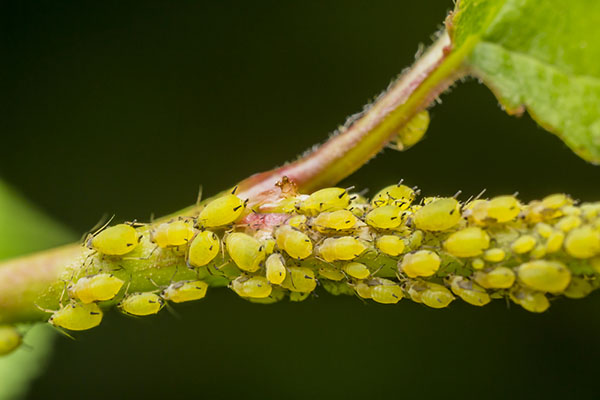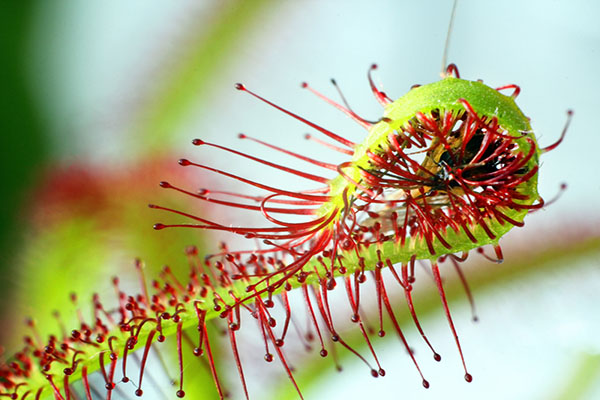Information that will help you battle the leaf-eating bugs that are going after your garden.

Why Won’t Your Garden Grow?
No matter how much time you put into garden planning, no matter how great your backyard ideas are, it’s hard to control nature and everything it entails. One of the most common wrenches nature will throw at your vegetable garden is unwanted visitors – in particular, leaf-eating insects.
Putting Your (Green) Thumb on the Problem
There are thousands of insects that eat plants, but here are some of the most common that you’ll find in vegetable gardens.

Aphids at work.
-
Aphids:
The most common garden insect. Feeds on all plants and vegetables. Fine in small numbers, but populations can rapidly grow out of control. Colonies are found on the underside of leaves. Very small, but can transmit plant viruses and ruin vegetables.
-
Flea beetles:
Feed on various vegetables, but particularly love crucifers, such as cabbage and broccoli, or solanaceous plants, such as potato, eggplant and tomato. Have powerful hind legs, enabling them to jump from plant to plant. Many different variants exist, including spinach, grape, sweet potato and striped flea beetles. The corn flea beetle can transmit bacterium that causes Stewart’s wilt on sweet corn.
-
Leafhoppers:
Feed on bean, potato, eggplant, celery, beet and tomato plants, among others.Create holes by sucking plant juices out of the bottom of leaves. Populations can rapidly expand in short periods of time, but are easily controlled with garden pesticides. Potato leafhoppers can cause ‟hopperburn” on potato, bean, eggplant and rhubarb plants, while beet leafhoppers transmit the ‟curly top” disease to beets.
-
Various beetle species:
Feed on every type of vegetable, plant, tree and aspect of your landscape. A big concern in lawn care as well. Voracious appetites make beetles a top enemy of home gardeners. Some species of particular concern include Japanese beetles, striped blister beetles, asparagus beetles, Colorado potato beetles, striped and spotted cucumber beetles and the bean leaf and Mexican beetles.
-
Various worm species:
Feed on all types of vegetables and plants, with the most common problematic species being cutworms, wireworms, imported cabbage worms, cabbage loopers, hornworms, corn earworms and tomato fruit worms. These species fall into two general categories: those that feed on leafy greens such as broccoli, brussels sprouts, cabbage, cauliflower, collards, kale, mustards, lettuce, celery, radishes and spinach; and those that feed on tomatoes, potatoes, corn, beans, okra and eggplant.
Other common garden pests include caterpillars, slugs, earwigs, stink bugs, European corn borers, squash borers, squash bugs, two-spotted spider mites and diamondback moths. The University of Minnesota Extension provides an excellent resource, allowing you to pinpoint your problem by type of plant and specific symptoms.
Organic Garden
In many gardens, allowing ground beetles, ladybugs, spiders, birds, lacewings, hover flies and dragonflies to flourish will naturally curb garden pests. When the natural predators of leaf-eating insects aren’t enough, you might have to resort to mild pest control. Organic pesticides are a great way to kill bugs in gardens because you don’t want to use anything that would possibly endanger you, your family, pets or neighbors.
The University of Arizona Cooperative Extension suggests a safe home remedy for garden pests that combines non-detergent dish soap with water and vegetable oil. Other common organic solutions of this nature can include the use of vinegar, baby shampoo and rubbing alcohol.
But as the Oregon State University Extension Service points out, plants with ‟hairy” leaves will hold soapy solutions longer. This becomes problematic with direct sunlight, as it can cause some plants to burn, especially if the solution is too strong or the plants aren’t properly hydrated. To avoid burning, always test your solution on small patches of leaves first, before applying to the entire garden.
Fight Fire with Fire: Insect-Eating Plants
Another – slightly outside the box – option is to attack back with insect-eating plants. These types of plants will only grow in certain areas, depending on climate and your ability to provide the right environment. However, if you like the idea of a vegetable garden that defends itself against insects naturally, here are a few of your options.

Sundew having lunch.
-
Butterwort:
This plant is like flypaper, trapping any insect unfortunate enough to crawl or land onto it with glue-like efficiency. The butterwort then liquefies the insect and absorbs its nutrients. Butterworts can also sprout a single stem with one blossom, but are mainly made up of stemless rosettes.
-
Sundew:
The Drosera – commonly called sundew – plant is gorgeous to look at but deadly to insects. Its dew-covered tentacles can move, bringing a trapped insect into contact with as many ‟sticking points” as possible. It then liquefies and digests the insect for nutrients.
-
Flytrap:
The most famous of the insect-eating plants, this organism opens its convex lobes to reveal a juicy, pink meat that lures insects in. Once an insect lands, the hairs on the surface of the plant are triggered, snapping the trap shut. This effectively forms a stomach, which digests the meal.
Nothing can make a plant nursery or garden look worse than having chewed up holes in the plants’ leaves and fruits, but it should stop there. If plant bugs – or any pests – have made their way inside your home, it’s a good idea to contact a pest management professional right away.


